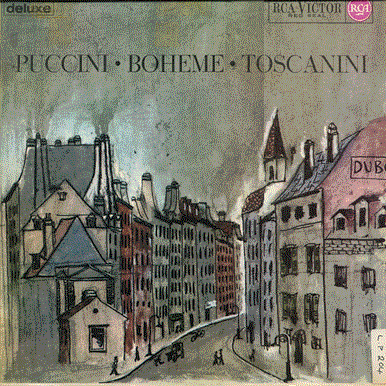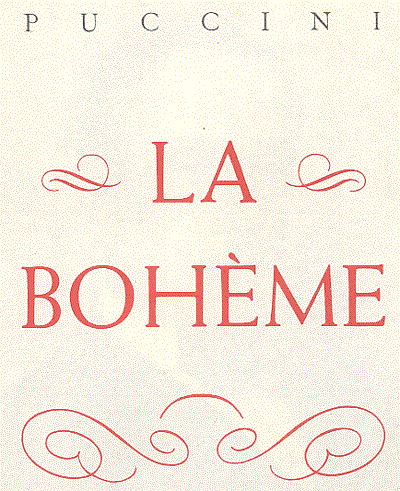

LA BOHÈME - OPERA IN QUATTRO ATTI

( View LP Cover )
LA
BOHÈME OPERA IN QUATTRO ATTI
|
|||
|
|
ACT 1 | ||
|
|
ACT 2 | ||
|
|
ACT 3 | ||
|
|
ACT 4 | ||
|
|
|
LA BOHÈME OPERA IN QUATTRO ATTI |
| By George R. Marek Torre del Lago era, al tempo in cui Puccini vi si stabilì, un villaggio di forse 120 abitanti, tra Viareggio e Pisa, sulle rive del piccolo e poco profondo lago di Massaciuccoli; s'ergono tutt'intorno montagne scure e le nuvole vi s'impigliano, cosicché spesso ci piove. Tra tutti i luoghi allegri e inondati di sole dell'Italia del nord, Puccini scelse come « suprema gioia, paradiso, Eden, Empireo, torre d'avorio, vas spirituale » come poeticamente scriveva, un posto di non grande bellezza scenica e di aspetto decisamente malinconico. Tre furono le ragioni che spinsero il compositore a scegliere questa località: Torre del Lago non era un paese alla moda e quindi spendendo relativamente poco si poteva comprare od affittare una casa, si trovava in una posizione che si raggiungeva scomodamente ed infine era un ottimo terreno di caccia. Poco tempo dopo Puccini si era fatto un gruppo di amici, gente semplice, per lo più artisti di mediocre levatura, che lavoravano nella regione e non erano schiavi del parlar forbito e dei vestiti eleganti ma conducevano una vita sana, quasi identificandosi con i personaggi della Bohème, 31 noto romanzo autobiografico di H. Murger. E questo fu proprio il periodo più felice della vita del musicista: era giovane e senza preoccupazioni finanziarie, i suoi rapporti con Elvira erano ancora buoni, innamorato com'era di lei; ed era completamente immerso a scrivere un'opera del cui valore era sicuro fin dal principio. Se la Manon gli aveva dato coraggio, la Bohème era senz'altro un dramma migliore e Mimi più interessante di Ma-non; e dopo il successo di Manon era logico che Giacosa e Illica fossero stati scelti come librettisti del nuovo lavoro. Tra l'altro i due scrittori si completavano a vicenda; Illica era dotato di carattere impulsivo e dava poca importanza alla precisione, che affidava a Giacosa, molto più accurato. Tuttavia questa nuova composizione sorse fra non poche difficoltà e determinò la rottura dei rapporti amichevoli esistenti tra Puccini e LeoncavalloInfatti quando quest'ultimo apprese dalle stesse labbra del primo l'intenzione di creare della musica attorno ai personaggi dei noto lavoro di Murger, inveì violentemente contro Puccini ricordandogli di avergli proposto anni prima il libro e di aver ricevuto un rifiuto. « Allora decisi di tenerlo per me », disse a conclusione del suo discorso, « e così farò. Uscirà una Bohème con la mia musica e non con la tua ». Sfortunatamente anche Puccini era della stessa idea e affermò: «Allora ci saranno due Bohème! ». Poi fu la corsa sfrenata alla composizione, e. i due autori si adoperarono febbrilmente affinchè il loro lavoro risultasse il migliore. L'opera di Leoncavallo comparve un anno dopo quella di Puccini ed ebbe la sua prima rappresentazione alla Fenice di Venezia il 6 maggio 1897. Benchè fosse un lavoro di un certo valore non ottenne grande successo, gettata come fu nell'ombra dal capolavoro di Puccini; d'un certo interesse storico tuttavia rimane il fatto che Caruso ottenne con questa opera i suoi primi applausi. Per quanto riguarda invece la composizione del rivale,il libretto di Illica contava in un primo tempo non meno di venti atti e prima che questi fossero ridotti a quattro e i versi suonassero passabili trascorsero tre lunghi anni. Finalmente, nel dicembre 1895, la prima dell'Opera fu fissata per il carnevale, a Torino, nonostante le continue e vivaci pressioni degli altri teatri per avere l'onore di tenerla a battesimo. Il direttore è stato già prescelto nella persona di Arturo Toscanini, un giovane di appena 28 anni che si è fatto un certo nome in Italia e che già comincia ad essere conosciuto all'estero e a ricevere le prime lusinghiere offerte. La sera della prima un pubblico scelto affolla la sala, ed in mezzo ad esso si possono notare alcuni dei compositori più conosciuti. Alla fine del primo atto, Puccini è chiamato più volte alla ribalta, il secondo ed il terzo si chiudono con applausi e consensi, ma il quarto atto è quello che conquista veramente tutto il pubblico. Ascoltato con la più grande attenzione e con il più grande silenzio, al suo termine fa scattare tutti gli spettatori in piedi, entusiasti, che chiamano Puccini per ben quindici volte ». Tuttavia questa accoglienza, che pure può considerarsi non tiepida, non raggiunse le altezze di quella che fu riservata alla presentazione di Manon. E vien fatto di chiedere quali furono le ragioni che determinarono ciò, dal momento che l'opera era senza dubbio melodiosa, semplice ed immediata ed aveva tutti i numeri per un completo, sicuro successo. Si può rispondere che i critici, pur non rivelando palesemente un certo scetticismo, mostrarono di voler giudicare con una certa severità ,unita ad una buona dose di diffidenza ,questo nuovo lavoro del compositore « di moda », forse gelosi del suo successo e che anche il pubblico nella sua « risposta » si era fattoinfluenzare dalla critica, oppure come Toscanini fti d'accordo nell'ammettere, esso si aspettava un lavoro solido, imponente. A tutto questo si aggiunga il momento in cui fu data la rappresentazione, reso poco propizio da questioni imponderabili che però nel mondo del teatro hanno il loro peso, per avere un quadro completo dell'atmosfera che accolse la Bohème. Tuttavia l'elevato numero di repliche, a tutto esaurito, compensò l'autore della insufficientemente entusiasta atmosfera iniziale, e l'accoglienza che l'opera ottenne a Manchester nel 1897, al Covent Garden la stagione seguente, a New York nel 1898 una prima volta ed una seconda nel 1900 al teatro Metropolntan, decretarono l'indiscusso successo dell'opera. «La Bohème» è il lavoro di Puccini che piace di più, è l'opera che ci procura il piacere più immediato e più semplice, pur essendo superata dalla « Tosca » per forza drammatica, dalla « Butterfly » per lirismo, dalla « Fanciulla del West » per l'orchestrazione, dalla « Turandot » per il valore intrinseco della musica. Considerando l'opera nel suo insieme si osserva che essa è un lavoro « a sè stante », una creazione d'arte che ha un suo mondo, un suo stile, staccantesi nettamente dalle altre composizioni e recante chiara l'impronta dell'artista. E pur essendo Puccini un musicista che amava ripetersi, più di tanti altri, tuttavia egli non ricreò mai più in altre sue composizioni quell'atmosfera e quell'insieme che resero tanto singolare e tanto perfetta la Bohème. Un'opera, questa, che al pregio indiscutibile già accennato unisce altre positive caratteristiche di un lavoro di successo: la aderenza logica al testo preso come « canovaccio », la coerenza alla propria legge interna e la facoltà di creare in chi ascolta un quadro completo, una completa impressione. La Bohème è ricca di verismo artistico e se il romanzo da cui ha preso lo spunto è auto-biografico anche la sua musica è tale per l'assoluta fedeltà all'opera letteraria da cui ha tratto lo spunto. E mentre nella Butterfly Puccini volge la sua attenzione a delineare il personaggio di Cio-Cio-San, arricchendolo di fascino e concretandolo musicalmente e non si preoccupa affatto di dare rilievo agli altri interpreti, facendo di essi solo figure e non personaggi, nella Bohème, Rodolfo, Marcello e Colline hanno una « personalità » inferiore a quella di Mimi, forse solo per cavalleria, e Schaunard, Musetta e Benoît possono considerarsi personaggi di secondo piano, ma non per questo di minore interesse. Si suole paragonare molto spesso la Bohème alla Traviata, sebbene tale confronto ai conoscitori delle due opere appaia piuttosto azzardato. Infatti esse non hanno in comune altro che l'essere tratte ambedue da due noti lavori letterari, mentre risulterà evidente a qualsiasi osservatore la differenza del carattere delle due protagoniste: più gaia, più leggera Mimi, più s forte* e drammatica Violetta; inoltre mentre la Traviata è senz'altro una tragedia romantica, la Bohème è una commedia romantica con una triste conclusione, che non raggiunge il pathos a cui arriva Verdi nella seconda parte del suo quarto atto. Tuttavia nella Bohème Puccini dimostra di aver raggiunto un notevole progresso nella padronanza dell'orchestrazione, libera da influenze pseudo-wagneriane, e ricca di un nuovo personale stile. L'intero movimento è più libero, le sue armonie sono più espressive, i suoi colori tonali meno abbaglianti. Con effetti ereditati da Verdi egli unisce l'orchestra alla voce e lascia quest'ultima libera al principio ed alla fine di ogni aria, quasi a creare una cornice all'aria stessa. Questa inizia e termina su di una nota sola come se fosse un « recitativo », raggiungendo l'effetto di una calma e pacata tenerezza; mentre efficaci pause rendono stupendamente la tristezza che si sente aleggiare ad ogni interruzione di frase musicale. Se è certo che la Bohème non può considerarsi un colosso musicale, senza dubbio dobbiamo riconoscere che è un'opera che rivela appieno i progressi fatti da Puccini e il suo genio musicale; un'opera dalla lunga giovinezza, perché essa rimarrà viva finché i sentimenti che esprime resteranno il fondamento istesso dell'arte da noi vagheggiata. E forse, dopo tutto, non è errato considerarla un'opera immortale. LA REGISTRAZIONE Il 3 e il 10 febbraio 1946, cinquanta anni dopo esser salito sul podio del Teatro di Torino per la prima mondiale, Arturo Toscanini diresse di nuovo l'Orchestra Sinfonica della NBC, unitamente ad uno scelto c cast r di interpreti nell'esecuzione radiodiffusa della Bohème di Puccini. Questa seconda interpretazione ben diversa dalla precedente per la maturità artistica raggiunta dal maestro e per L'interpretazione di Jan Peerce, Licia Albanese, Francesco Valentino riscosse un notevole successo. I complicati processi acustici ai quali i tecnici della RCA Victor dovettero sottoporre la registrazione originale al fine di migliorarla hanno reso l'incisione che vi presentiamo quasi perfetta; tuttavia l'alto valore storico e critico che i dischi rivestono fanno passare in secondo piano la stessa perfezione della realizzazione tecnica. |
LA BOHÈME OPERA IN FOUR ACTS |
By George R. Marek |



